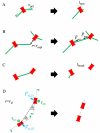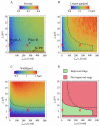Model of myosin node aggregation into a contractile ring: the effect of local alignment
- PMID: 21862839
- PMCID: PMC3180958
- DOI: 10.1088/0953-8984/23/37/374103
Model of myosin node aggregation into a contractile ring: the effect of local alignment
Abstract
Actomyosin bundles frequently form through aggregation of membrane-bound myosin clusters. One such example is the formation of the contractile ring in fission yeast from a broad band of cortical nodes. Nodes are macromolecular complexes containing several dozens of myosin-II molecules and a few formin dimers. The condensation of a broad band of nodes into the contractile ring has been previously described by a search, capture, pull and release (SCPR) model. In SCPR, a random search process mediated by actin filaments nucleated by formins leads to transient actomyosin connections among nodes that pull one another into a ring. The SCPR model reproduces the transport of nodes over long distances and predicts observed clump-formation instabilities in mutants. However, the model does not generate transient linear elements and meshwork structures as observed in some wild-type and mutant cells during ring assembly. As a minimal model of node alignment, we added short-range aligning forces to the SCPR model representing currently unresolved mechanisms that may involve structural components, cross-linking and bundling proteins. We studied the effect of the local node alignment mechanism on ring formation numerically. We varied the new parameters and found viable rings for a realistic range of values. Morphologically, transient structures that form during ring assembly resemble those observed in experiments with wild-type and cdc25-22 cells. Our work supports a hierarchical process of ring self-organization involving components drawn together from distant parts of the cell followed by progressive stabilization.
Figures








Similar articles
-
Roles of formin nodes and myosin motor activity in Mid1p-dependent contractile-ring assembly during fission yeast cytokinesis.Mol Biol Cell. 2009 Dec;20(24):5195-210. doi: 10.1091/mbc.e09-05-0428. Mol Biol Cell. 2009. PMID: 19864459 Free PMC article.
-
A node organization in the actomyosin contractile ring generates tension and aids stability.Mol Biol Cell. 2017 Nov 7;28(23):3286-3297. doi: 10.1091/mbc.E17-06-0386. Epub 2017 Sep 27. Mol Biol Cell. 2017. PMID: 28954859 Free PMC article.
-
Mechanoregulated inhibition of formin facilitates contractile actomyosin ring assembly.Nat Commun. 2017 Sep 26;8(1):703. doi: 10.1038/s41467-017-00445-3. Nat Commun. 2017. PMID: 28951543 Free PMC article.
-
Contractile-ring assembly in fission yeast cytokinesis: Recent advances and new perspectives.Cytoskeleton (Hoboken). 2012 Oct;69(10):751-63. doi: 10.1002/cm.21052. Epub 2012 Aug 23. Cytoskeleton (Hoboken). 2012. PMID: 22887981 Free PMC article. Review.
-
Progress towards understanding the mechanism of cytokinesis in fission yeast.Biochem Soc Trans. 2008 Jun;36(Pt 3):425-30. doi: 10.1042/BST0360425. Biochem Soc Trans. 2008. PMID: 18481973 Free PMC article. Review.
Cited by
-
Animal Cell Cytokinesis: The Rho-Dependent Actomyosin-Anilloseptin Contractile Ring as a Membrane Microdomain Gathering, Compressing, and Sorting Machine.Front Cell Dev Biol. 2020 Oct 7;8:575226. doi: 10.3389/fcell.2020.575226. eCollection 2020. Front Cell Dev Biol. 2020. PMID: 33117802 Free PMC article.
-
Fission yeast type 2 node proteins Blt1p and Gef2p cooperate to ensure timely completion of cytokinesis.BMC Mol Cell Biol. 2019 Jan 24;20(1):1. doi: 10.1186/s12860-018-0182-z. BMC Mol Cell Biol. 2019. PMID: 31041892 Free PMC article.
-
The value of mechanistic biophysical information for systems-level understanding of complex biological processes such as cytokinesis.Biophys J. 2014 Dec 2;107(11):2499-507. doi: 10.1016/j.bpj.2014.10.031. Epub 2014 Dec 2. Biophys J. 2014. PMID: 25468329 Free PMC article. Review.
-
The Rho-GEF Gef3 interacts with the septin complex and activates the GTPase Rho4 during fission yeast cytokinesis.Mol Biol Cell. 2015 Jan 15;26(2):238-55. doi: 10.1091/mbc.E14-07-1196. Epub 2014 Nov 19. Mol Biol Cell. 2015. PMID: 25411334 Free PMC article.
-
α-Actinin and fimbrin cooperate with myosin II to organize actomyosin bundles during contractile-ring assembly.Mol Biol Cell. 2012 Aug;23(16):3094-110. doi: 10.1091/mbc.E12-02-0123. Epub 2012 Jun 27. Mol Biol Cell. 2012. PMID: 22740629 Free PMC article.
References
-
- Liverpool TB, Marchetti MC. Phys. Rev. Lett. 2003;90:138102. - PubMed
-
- Cytrynbaum EN, Rodionov V, Mogilner A. J. Cell Sci. 2004;117:1381–97. - PubMed
-
- Kruse K, Joanny JF, Julicher F, Prost J, Sekimoto K. Phys. Rev. Lett. 2004;92:078101. - PubMed
-
- Kierfeld J, Khne T, Lipowsky R. Phys. Rev. Lett. 2005;95:038102. - PubMed
-
- Backouche F, Haviv L, Groswasser D, Bernheim-Groswasser A. Phys. Biol. 2006;3:264–73. - PubMed
Publication types
MeSH terms
Substances
Grants and funding
LinkOut - more resources
Full Text Sources
Research Materials
